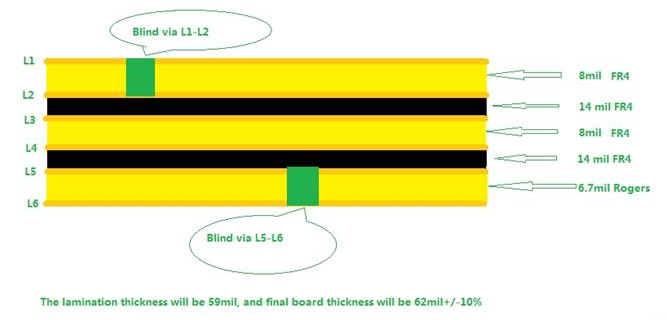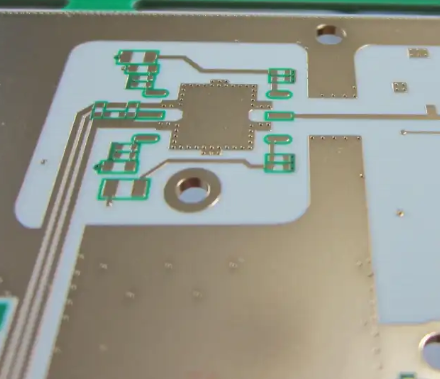Rogers pcb thickness
Importance Of Rogers PCB Thickness In High-Frequency Applications
In the realm of high-frequency applications, the importance of Rogers PCB thickness cannot be overstated. Rogers Corporation, a renowned manufacturer of high-performance circuit materials, offers a variety of substrates specifically designed to meet the stringent demands of high-frequency and microwave applications. The thickness of these printed circuit boards (PCBs) plays a crucial role in determining their performance, reliability, and overall efficiency.
To begin with, the thickness of a Rogers PCB directly influences its electrical properties, which are paramount in high-frequency applications.
Thicker PCBs tend to exhibit lower signal loss, which is essential for maintaining signal integrity over long distances. This is particularly important in applications such as telecommunications, radar systems, and satellite communications, where even minor signal degradation can lead to significant performance issues. By carefully selecting the appropriate thickness, engineers can optimize the dielectric properties of the PCB, thereby ensuring minimal signal attenuation and phase distortion.
Moreover, the thermal management capabilities of a Rogers PCB are also affected by its thickness.
High-frequency applications often generate substantial amounts of heat, which must be efficiently dissipated to prevent damage to the components and ensure stable operation. Thicker PCBs provide better thermal conductivity, allowing for more effective heat dissipation. This is especially critical in power amplifiers and other high-power devices, where excessive heat can lead to thermal runaway and eventual failure. Therefore, selecting the right PCB thickness is essential for maintaining the thermal stability and longevity of high-frequency circuits.
In addition to electrical and thermal considerations, mechanical stability is another factor influenced by PCB thickness. Thicker PCBs offer greater rigidity and structural integrity, which is vital in applications subjected to mechanical stress or vibration. For instance, aerospace and automotive industries often require PCBs that can withstand harsh environmental conditions without compromising performance. By opting for a thicker Rogers PCB, engineers can enhance the mechanical robustness of their designs, ensuring reliable operation even in demanding scenarios.

Furthermore, the manufacturing process and cost implications of Rogers PCB thickness must also be taken into account.
Thicker PCBs generally require more material and longer processing times, which can increase production costs. However, the benefits of improved performance and reliability often outweigh these additional expenses, particularly in high-frequency applications where precision and dependability are paramount. It is essential for engineers to strike a balance between performance requirements and budget constraints when determining the optimal PCB thickness for their specific application.
Transitioning to the aspect of design flexibility, Rogers PCBs offer a range of thickness options, allowing engineers to tailor their designs to meet specific performance criteria.
This versatility is particularly advantageous in the development of custom solutions for niche applications. By leveraging the various thicknesses available, designers can fine-tune their circuits to achieve the desired electrical, thermal, and mechanical properties, thereby optimizing overall system performance.
In conclusion, the thickness of Rogers PCBs is a critical parameter that significantly impacts the performance, reliability, and efficiency of high-frequency applications. By carefully considering the electrical, thermal, and mechanical implications of PCB thickness, engineers can make informed decisions that enhance the functionality and longevity of their designs. While thicker PCBs may entail higher production costs, the benefits they offer in terms of signal integrity, thermal management, and mechanical stability make them an indispensable choice for high-frequency and microwave applications.

How To Choose The Right Rogers PCB Thickness For Your Project
When selecting the appropriate Rogers PCB thickness for your project, it is crucial to consider several factors that can significantly impact the performance and reliability of your final product. Rogers Corporation, renowned for its high-frequency laminates, offers a variety of materials that cater to different applications, each with unique properties and thickness options. Understanding these variables will help you make an informed decision that aligns with your project’s specific requirements.
Firstly, the operating frequency of your application plays a pivotal role in determining the suitable PCB thickness.
High-frequency applications, such as RF and microwave circuits, often demand thinner laminates to minimize signal loss and maintain signal integrity. Thinner substrates reduce the dielectric loss, which is essential for maintaining the efficiency of high-frequency signals. Conversely, for lower frequency applications, thicker laminates may be more appropriate as they provide better mechanical stability and can handle higher power levels without compromising performance.
Another critical factor to consider is the thermal management of your PCB.
Thicker laminates generally offer better heat dissipation, which is vital for applications involving high power or high-temperature environments. Effective thermal management ensures that the components on the PCB operate within their specified temperature ranges, thereby enhancing the overall reliability and lifespan of the device. Therefore, if your project involves significant heat generation, opting for a thicker Rogers PCB can be advantageous.
Mechanical strength and rigidity are also essential considerations when choosing the right PCB thickness.
Thicker PCBs provide greater structural integrity, which is particularly important for applications subjected to mechanical stress or vibration. For instance, in automotive or aerospace applications, where the PCB may experience harsh conditions, a thicker laminate can prevent warping and ensure the durability of the circuit. On the other hand, if your project requires a flexible or lightweight design, a thinner PCB might be more suitable.
The manufacturing process and cost implications are additional aspects that should not be overlooked.
Thicker PCBs can be more challenging to fabricate, potentially leading to higher production costs and longer lead times. It is essential to balance the performance benefits of a thicker laminate with the practical considerations of manufacturing and budget constraints. Consulting with your PCB manufacturer can provide valuable insights into the feasibility and cost-effectiveness of different thickness options for your specific project.
Furthermore, the choice of Rogers material itself can influence the optimal thickness.
Rogers offers a range of materials, such as RO4000, RO3000, and RO5000 series, each with distinct characteristics tailored to various applications. For example, the RO4000 series is known for its excellent high-frequency performance and is available in multiple thicknesses to suit different design needs. Understanding the properties of the specific Rogers material you intend to use will help you determine the most appropriate thickness for your application.
In conclusion, selecting the right Rogers PCB thickness for your project involves a careful evaluation of several factors, including operating frequency, thermal management, mechanical strength, manufacturing considerations, and the specific Rogers material. By thoroughly assessing these elements and consulting with experts, you can ensure that your PCB design meets the performance, reliability, and cost requirements of your application. Making an informed decision on PCB thickness is a critical step in achieving a successful and efficient electronic design.

Impact Of Rogers PCB Thickness On Signal Integrity
The impact of Rogers PCB thickness on signal integrity is a critical consideration in the design and manufacturing of high-frequency printed circuit boards (PCBs). Rogers Corporation, a renowned manufacturer of high-performance PCB materials, offers a variety of substrates that are specifically engineered to meet the stringent demands of high-frequency applications. The thickness of these substrates plays a pivotal role in determining the overall performance and reliability of the PCB, particularly in terms of signal integrity.
Signal integrity refers to the quality and reliability of the electrical signals transmitted through the PCB.
It is influenced by various factors, including the dielectric properties of the substrate material, the layout of the traces, and the thickness of the PCB. Rogers materials are known for their low dielectric constant (Dk) and low loss tangent, which are essential for maintaining signal integrity at high frequencies. However, the thickness of the Rogers PCB can significantly affect these properties and, consequently, the signal integrity.
One of the primary ways in which PCB thickness impacts signal integrity is through impedance control.
Impedance is the measure of resistance that a circuit offers to the flow of alternating current (AC) and is a critical parameter in high-frequency designs. The impedance of a trace on a PCB is determined by the trace width, the dielectric constant of the substrate, and the thickness of the substrate. Thicker substrates generally result in higher impedance, which can lead to signal reflections and loss if not properly managed. Therefore, precise control of PCB thickness is essential to ensure that the impedance remains within the desired range, thereby minimizing signal degradation.
Another important aspect to consider is the propagation delay, which is the time it takes for a signal to travel from one point to another on the PCB.
The propagation delay is influenced by the dielectric constant of the substrate and the thickness of the PCB. Thicker PCBs can increase the propagation delay, which may not be desirable in high-speed applications where timing is critical. Designers must carefully balance the thickness of the PCB to achieve the optimal propagation delay while maintaining other performance parameters.
Moreover, the thickness of the Rogers PCB can also affect the crosstalk between adjacent traces.
Crosstalk is the unwanted coupling of signals between nearby traces, which can lead to signal interference and degradation. Thicker substrates can help reduce crosstalk by increasing the distance between the traces and the reference plane, thereby providing better isolation. However, this must be balanced against other design considerations, such as the overall size and weight of the PCB.
Thermal management is another factor influenced by PCB thickness.
Thicker PCBs can provide better heat dissipation, which is crucial in high-power applications. However, this can also lead to increased manufacturing costs and potential challenges in achieving fine trace geometries. Therefore, designers must carefully consider the trade-offs between thermal performance and other design requirements.
In conclusion, the thickness of Rogers PCBs has a profound impact on signal integrity, influencing factors such as impedance control, propagation delay, crosstalk, and thermal management. Achieving optimal signal integrity requires a careful balance of these factors, taking into account the specific requirements of the application. By understanding the interplay between PCB thickness and signal integrity, designers can make informed decisions that enhance the performance and reliability of their high-frequency PCB designs.
Comparing Different Rogers PCB Thickness Options For Optimal Performance
When selecting materials for printed circuit boards (PCBs), the choice of substrate can significantly impact the performance and reliability of the final product. Among the various options available, Rogers PCBs are highly regarded for their superior electrical properties, making them a preferred choice in high-frequency and high-performance applications. One critical aspect to consider when working with Rogers PCBs is the thickness of the material, as it can influence several key performance parameters. Comparing different Rogers PCB thickness options is essential for optimizing performance and ensuring that the final product meets the desired specifications.
Rogers PCBs are available in a range of thicknesses, each offering distinct advantages and trade-offs.
Thicker substrates, for instance, provide greater mechanical strength and rigidity, which can be beneficial in applications where the PCB must withstand physical stress or environmental factors. Additionally, thicker PCBs can accommodate more complex designs with multiple layers, allowing for greater functionality and integration of components. However, the increased thickness can also lead to higher material costs and potential challenges in the manufacturing process, such as difficulties in achieving precise drilling and etching.
On the other hand, thinner Rogers PCBs offer advantages in terms of flexibility and weight reduction.
These characteristics are particularly valuable in applications where space and weight are critical constraints, such as in aerospace and portable electronic devices. Thinner substrates can also facilitate better heat dissipation, which is crucial in high-power applications to prevent overheating and ensure reliable operation. However, the reduced thickness may compromise the mechanical strength of the PCB, making it more susceptible to bending and damage during handling and assembly.
The electrical performance of Rogers PCBs is another crucial factor influenced by the thickness of the substrate.
Thicker PCBs generally exhibit lower signal loss and better impedance control, which are essential for maintaining signal integrity in high-frequency applications. This is because the increased thickness reduces the dielectric constant variation and minimizes the impact of surface roughness on signal transmission. Conversely, thinner PCBs may experience higher signal loss and greater susceptibility to electromagnetic interference (EMI), which can degrade the performance of high-speed circuits.
Thermal management is another aspect where the thickness of Rogers PCBs plays a significant role.
Thicker substrates can provide better thermal conductivity, helping to dissipate heat more effectively and maintain stable operating temperatures. This is particularly important in power electronics and RF applications, where excessive heat can lead to component failure and reduced lifespan. Thinner PCBs, while offering some thermal advantages due to their reduced mass, may require additional thermal management solutions, such as heat sinks or thermal vias, to ensure adequate heat dissipation.
In conclusion, selecting the appropriate thickness for Rogers PCBs involves a careful balance of mechanical, electrical, and thermal considerations.
Thicker substrates offer enhanced mechanical strength, better signal integrity, and improved thermal management, making them suitable for demanding applications with stringent performance requirements. Thinner substrates, on the other hand, provide advantages in terms of flexibility, weight reduction, and heat dissipation, making them ideal for space-constrained and portable applications. By understanding the trade-offs associated with different thickness options, designers can make informed decisions to optimize the performance and reliability of their Rogers PCBs, ensuring that the final product meets the desired specifications and operates effectively in its intended application.






